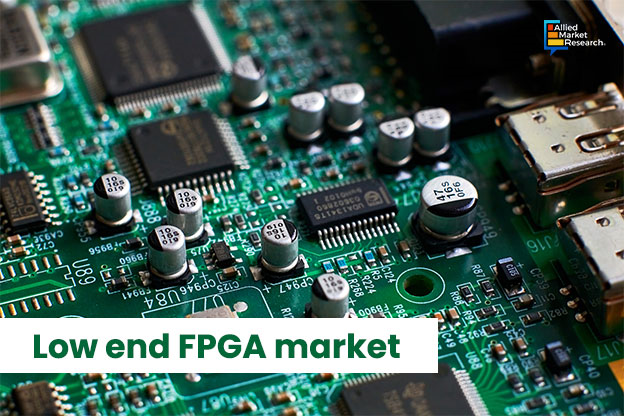Explained: The Diverse Applications of Low-End FPGAs and the Growth Drivers of the Market

4 Oct
2023
Field-programmable gate arrays are integrated circuits used to perform different digital functions. The stand-out feature of field-programmable gate arrays is that they can be programmed and reprogrammed even after they are manufactured. Field-programmable gate arrays thus offer flexibility and parallel processing capabilities which makes them highly popular in telecommunications, aerospace, and automobile manufacturing industries. Low-end field-programmable gate arrays are a type of field-programmable gate arrays which have simpler structures and have lower logic capacities. Hence, low-end field-programmable gate arrays are mainly used for small scale projects and applications.
Applications of low-end FPGAs
Low-end FPAs are primarily employed for applications wherein the power consumption is on the lower side, along with lower logic density. FPAs, in general, find applications in smart power grids wherein peak load management becomes extremely necessary. Hence, field-programmable gate arrays are used so as to lower the power consumption while maintaining the performance and scalability of the grids. One unique advantage of low-end field-programmable gate arrays is that their power leakage is very less. Hence, low-end FPGA-based storage has the ability to offer low static power, thus making them ideal for in-vehicle infotainment systems and cruise control systems.
Field-programmable gate arrays, especially rad-tolerant and rad-hard FPGAs are used in aerospace and defense industries owing to their ability to withstand harsh environments. Also, the flexibility of low-end FPGAs makes them ideal for processing intensive systems. FPGAs also have huge applicability in software defined networks and data centers. With increasing integration of Internet of Things and deep learning, the role of low-end FPGAs is bound to increase in the next few years.
Future growth opportunities for the market
As per a recently published report by Allied Market Research, the low-end FPGA market is anticipated to rise at a stunning CAGR of 9.5%. According to this report, the growing shift towards smart cities and industrial automation has led to widespread adoption of smart technologies, thereby leading to a surge in demand for FPGAs. Apart from this, since low-end FPGAs allow for customization and rapid prototyping, they offer enhanced connectivity and efficiency. This has further increased their demand from several end-use industries.
Another important factor behind the massive surge experienced by this market is the increasing popularity of smart home devices including voice-controlled assistants and interconnected devices. These smart devices use low-end FPGAs owing to their ability to offer flexible solutions and high connectivity capabilities. Thus, increased adoption of smart home devices has led to expansion of the scope of the market substantially in the recent past.
Product launches by leading companies
The low-end FPGA industry is a competitive one with many companies launching their own products to establish dominance over other companies. For instance, in November 2021, Renesas Electronics Corporation, a leading semiconductor company, announced the launch of a FPGA series. ForgeFPGA™, as this FPGA series is named, has garnered a lot of attention in the past few months owing to its low-cost and low power consumption properties. Such product launches have widened the scope of the market drastically in the past few years.
To conclude, the low-end FPGA market is set to witness a huge surge due to several applications of FPGAs in various end-use industries. Increasing adoption of smart devices and innovative product launches might augment the growth rate of the market in the coming period.

Koyel Ghosh
Author’s Bio- Koyel Ghosh is a blogger with a strong passion and enjoys writing in miscellaneous domains, as she believes it lets her explore a wide variety of niches. She has an innate interest in creativity and enjoys experimenting with different writing styles. A writer who never stops imagining, she has been serving the corporate industry for the last five years.
Avenue: Entire Library membership of Allied Market Research Reports at your disposal
- Avenue is an innovative subscription-based online report database.
- Avail an online access to the entire library of syndicated reports on more than 2,000 niche industries and company profiles on more than 12,000 firms across 11 domains.
- A cost-effective model tailored for entrepreneurs, investors, and students & researchers at universities.
- Request customizations, suggest new reports, and avail analyst support as per your requirements.
- Get an access to the library of reports at any time from any device and anywhere.
Related Post
-
How are Submarine Cables Transforming Global Connectivity with Enhanced User Experience?
-
Endoscopy Procedures: Transformations in Techniques and Applications
-
AI-Powered Video Analytics: How the Product Actually Works for enterprises
-
Painting Robots: Transforming Precision Coating and Creative Applications
-
Innovations in Pharmacovigilance Systems Advancing Patient Safety
-
Understanding Edge Security: Keeping Data Safe Near the Source
-
Exploring the Use and Advancements of 3D Laser Scanners in Professional Applications
-
Reinforcing Industrial Controls with Smarter Tools and Training








